Volcano Live
volcanolive.com
White Island Volcano | John Seach

(Whakaari)
Bay of Plenty, New Zealand
37.52 S, 177.78 E
summit elevation 321 m
stratovolcano
White Island is currently the most active volcano in New Zealand. It is located 48 km offshore in the Bay of Plenty at the northeastern extremity of Taupo Volcanic Zone. White Island is unusual because its active subaerial vent is located below sea level. The base of White Island is 300-400 m below sea level.
White Island Volcano photos by John Seach
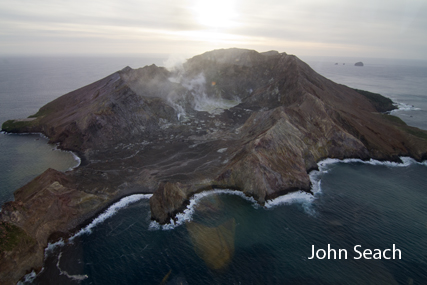
White Island, New Zealand 2011

White Island volcano 2010
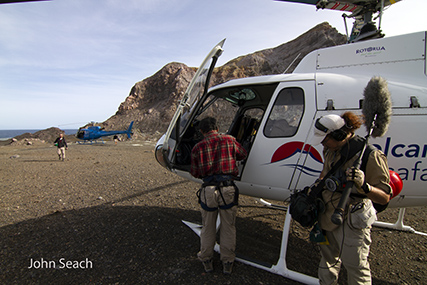
Landing 2 helicopters inside crater for our White Island documentary 2011
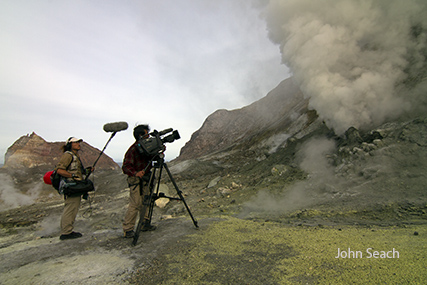
Filming roaring fumarole inside White Island volcano crater 2011.
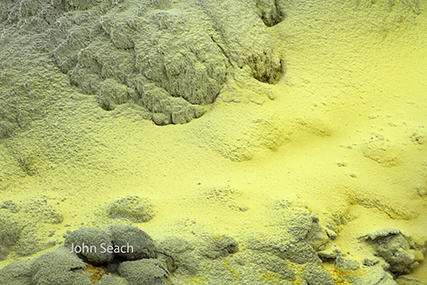
White Island volcano, solfatara 2011
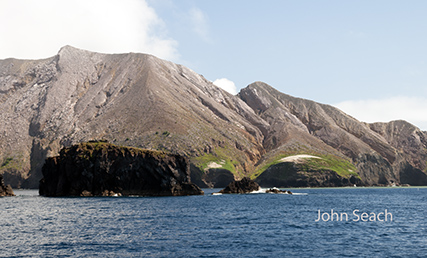
White Island volcano 2010

White Island volcano 2010

Tourist group inside crater of White Island volcano 2010
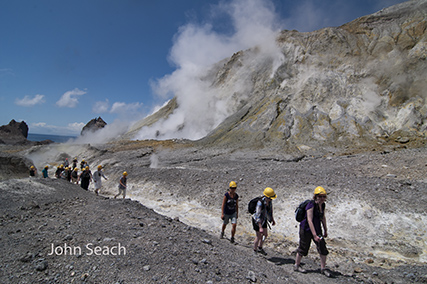
Tourists inside White Island crater 2010
More White Island volcano photos...
White Island consists of an older eroded western cone, and a younger central cone that forms most of the island. The volcano rises 700 m from the sea floor.
The volcano has a history of frequent small phreatic and phreatomagmatic eruptions,
interrupting long intervals of continuous intense, fumarolic and hydrothermal activity. Historically active vents are located in the western subcrater and the western half of the central subcrater. Fumaroles and hot springs discharge on the floor of the main crater, and represent the subaerial expression of a long-lived acidic hydrothermal system related to the deeper magmatic system of the volcano.
The floor of the main crater is covered by a debris avalanche deposit, with a hummocky topography which formed by crater wall collapse in September 1914, blocking a long-established vent system in the western subcrater.
Most of the island lacks vegetation due to the emission of toxic fumes from the crater. The island consists of two overlapping cones. The older cone is on the western part of the island. The younger cone comprises most of the island.
Breached crater at White Island
The main crater at White Island volcano is breached at three locations in the south east. This morphology is likely due to a telescoping porphyry and hydrothermal
alteration. The breached crater has allowed visitors to approach close to the active vents from sea level.
Hazards to visitors at White Island volcano
All of the historically active vents have been occurred in the north-west of main crater. Gases are continually emitted from the craters and fumaroles on White Island and pose a hazard to visitors to the volcano.
The western subcrater and central subcrater are the most dangerous locations for tourists to visit. The eastern subcrater close to the ocean is less dangerous. The zone for ballistic impacts covers all of the main crater, including all three subcraters. The slopes of the crater are steep and unstable and present a landslide hazard. Sulphur mining occurred at the island until 1914 when a crater collapse created a lahar which killed 10 workers. In 2012 more than 13,500 visitors per year visited White Island.
2024-2025 activity
Increasing ash emissions occurred at White Island in 2024, and continued into 2025.
2019 Eruption and fatalities
A 2-3 minute eruption of White Island volcano on 9 December 2019 caused 19 fatalities and numerous injuries. Ash emission reached 12,000 ft altitude.
The eruption was preceded by a new heating phase at the volcanic lake starting in August 2019, and and increase in S02 emission and volcanic tremor in November 2019. The alert status was raised to level 3 on 9th December 2019, and reduced to level 2 on 12th December 2019.
2016 Eruption
In mid April 2016 the ctater lake at White Island dropped 2 m. On 27th April 2016 a 90 minute eruption covered 80 per cent of the crater with dark-green ash. The lake floor dropped by 13 m.
2013 Activity
Hydrothermal activity was reported at a small hot lake at White Island volcano. The activity increased since late 2012 and became semi-continuous by 21st January 2013. It was the strongest activity at the volcano for years. Elevated levels of volcanic tremor were recorded.
A change in activity occurred at White Island volcano on 29th January 2013. The crater lake began drying out and small explosions of rock occurred from an area near the crater lake. Intermittent tremor was recorded. A small eruption occurred at White Island volcano on 20th August 2013. The eruption lasted 10 minutes and sent a plume to an altitude of 4000 m. The eruption occurred in a area of recent bubbling mud. The eruption was preceded by a short period of intense volcanic tremor the previous day.
2012 Eruption
A small eruption occurred at White Island volcano at 04:55 am on 6th August 2012. The eruption occurred at the crater lake and was preceded by strong volcanic tremor on 4-5 August. The crater lake had gradually emptied during 2011 and 2012, and the water level rose rapidly 3-5 m on 27-28 July 2012. On 12th December 2012 the alert at White Island volcano, New Zealand was raised to level 2 after a 20-30 m wide spiny lava dome was observed in a small crater. Tour operators on the island had noticed the lava dome for about 2 weeks. The dome possibly started forming after the August 2012 ash eruption. This is the first time a lava dome has been observed at White Island volcano.
2008 unrest
White Island's Crater Lake has continued to rise since December 2007, after being almost completely evaporated in late October 2007. By 23rd October 2008 the lake had risen by 15 m. New springs formed on the floor and old springs flowed again. Steam, gas, and mud emissions increased from the largest vent during October 2008.
1976-1982 Eruptions
The eruption sequence was the longest and largest historical event at the volcano. The eruptions consisted of seven phases of alternating phreatomagmatic and Strombolian explosions. The eruption was triggered by 10 million cubic metres of basic andesitic magma rising to shallow depths under the volcano. The eruption was preceded by uplift of the main crater floor in mid 1973. The first eruption in the series occurred on 18 December 1976 with phreatomagmatic eruptions. Strombolian eruptions began in March 1977. The final phreatomagmatic eruptions occurred in January 1892.
1968 eruption
During 1959 ash emissions occurred from Rudolf vent.
1959 eruption
During 1959 ash emissions occurred from Noisy Nellie and 1933 craters.
Further reading
Edwards, M.J., Kennedy, B.M., Jolly, A.D., Scheu, B. and Jousset, P., 2017. Evolution of a small hydrothermal eruption episode through a mud pool of varying depth and rheology, White Island, NZ. Bulletin of Volcanology, 79(2), p.16.
Cole, J.W., Thordarson, T. and Burt, R.M., 2000. Magma origin and evolution of White Island (Whakaari) volcano, Bay of plenty, New Zealand. Journal of Petrology, 41(6), pp.867-895.
Houghton, B.F. and Nairn, I.A., 1991. The 1976–1982 Strombolian and phreatomagmatic eruptions of White Island, New Zealand: eruptive and depositional mechanisms at a ‘wet’volcano. Bulletin of volcanology, 54(1), pp.25-49.
Black, P.M., 1970. Observations on white island volcano, New Zealand. Bulletin volcanologique, 34(1), pp.158-167.
White Island Volcano Eruptions
2024-25, 2019, 2012-13, 2001, 1998-2000, 1998, 1995, 1986-94, 1983-84, 1976-82, 1974, 1971, 1971, 1970, 1969, 1968-69, 1966-67, 1962, 1959, 1958, 1957, 1955, 1947, 1933, 1930, 1928, 1926, 1924, 1922, 1909, 1908?, 1886?,1886, 1885?, 1885, 1856?, 1836, 1826.